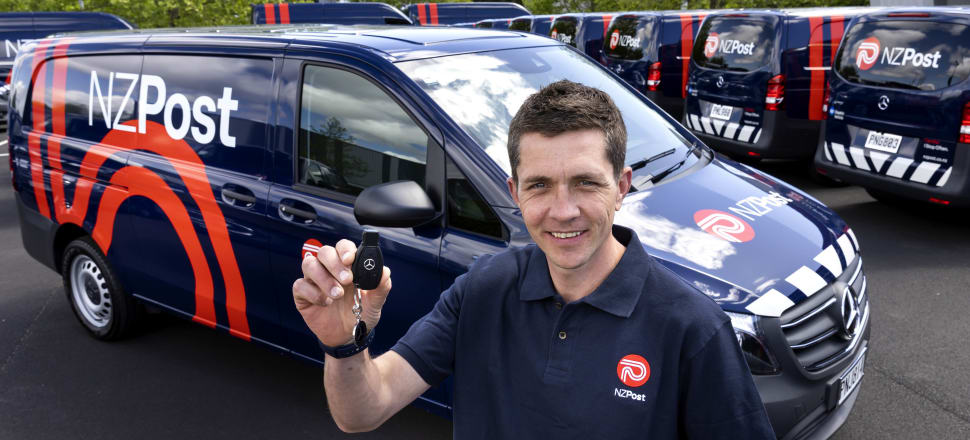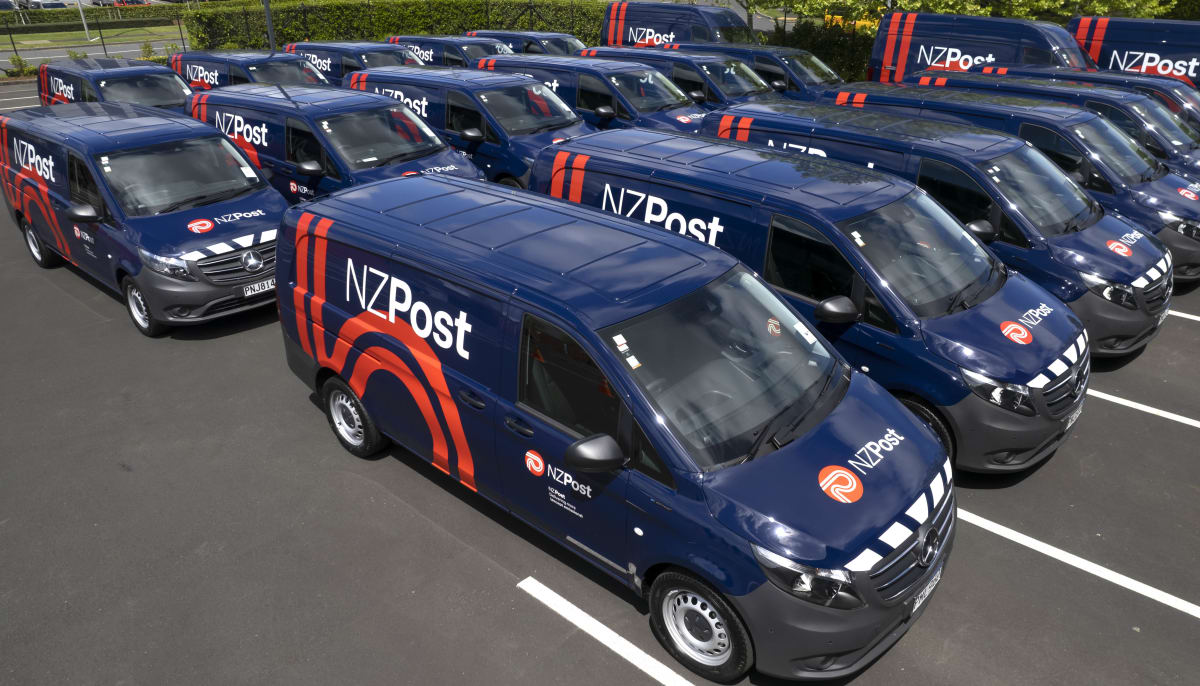
NZ Post is offering its courier drivers plenty of incentives to switch from diesel vans to state-of-the-art EVs – the first 20 of 60 Mercedes electric vans on order were rolled out this week
Gerrit Du Toit spent a lot of his childhood driving round Cape Town, South Africa in a Mercedes van with his courier driver dad.
Today he lives in Taupo having moved to New Zealand with his young family in 2019. He is a contractor to NZ Post and operates two courier runs that cover half the city.
Gerrit is also the poster boy for NZ Post’s campaign to get its contract couriers into new EVs. Where Gerrit goes, it wants others to follow.
Yesterday, after a launch function at NZ Post’s Auckland headquarters in Highbrook, Du Toit drove home to Taupo in his brand-new Mercedes EV. If he had paid retail price the van would have set him back $100,000 but Du Toit is the first beneficiary of Post’s plan to speed up its transition to low emission vehicles.
The plan includes providing lower interest loans and cash incentives to couriers buying the Mercedes vans purchased as part of the bulk order placed with the German automaker last December. The vans are being made at the company’s plant in Spain.
NZ Post Group Sustainability Manager Dawn Baggaley says with New Zealand being a relatively small and remote country it is not the highest priority for EV manufacturers. The company felt it couldn’t risk waiting for the price of EVs to fall – particularly during a time of ongoing supply chain issues.

“In two years, we might have price parity (with ICE vehicles) but we don’t want to wait. We have our science-based target to reduce emissions by 32 percent by 2030. We want our own fleet to be electric by 2025 and at least 25 percent of our contractor fleet electrified by then. So, we want to get moving. For us to be a low carbon delivery business we must swap out these fossil fuel modes of transport as soon as we can.”
To help it come up with the right vehicle and proposition for its contract couriers NZ Post brought in fleet transition specialist Carbn Asset Management (CAM).
“They didn’t want to throw a party that no one came to,” says CAM’s Transformation Director Richard Christensen whose team started work on the project 18 months ago.
“We started with what is meaningful to the people driving the vans. We surveyed the couriers and then aggregated the data.
"The upfront cost of an EV is the biggest barrier. We had to get the total cost of ownership close to their current diesel models." – Richard Christensen, CAM
“Things that were important were features like dual sliding doors (sliding doors on both sides of the van. A lift up tail gate. It might not sound like a big issue but for drivers unloading parcels in the rain it acts like an umbrella and the parcels don’t get wet.”
Christensen says the EVs needed to have a cargo capacity of six to seven cubic meters and a 250km range.
Three quarters of NZ Post’s 2000 drivers cover less than 250kms a day.
“When we considered all the factors and Mercedes came out head and shoulders above the others. They are a lovely vehicle to drive. They have some great innovations. When parcels are stacked up in a van you can’t see out the back, but Mercedes rear vision mirrors take a camera feed that gives a full representation of what is happening behind the van.”

Technologically advanced yes, but compared to a Toyota Hiace, the choice of many contract couriers, the Mercedes is roughly double the price. Christensen says all those involved in the project had to put themselves in the courier’s shoes.
“How do they pay for the thing; the upfront cost of an EV is the biggest barrier. We had to get the total cost of ownership close to their current diesel models. We know that the operating costs of an EV are much lower and the maintenance costs are much lower but the initial capital outlay for an EV is higher.”
NZ Post’s Baggaley says tackling the upfront price problem required a three-pronged approach.
First, Post partnered with New Zealand Green Investment Finance – a green investment bank established by the New Zealand Government. Both put $10 million dollars into a special fund run by Sustainable Fleet finance.
“Sustainable Fleet Finance (SFF) offers the financing to contractors. It will draw down the funding from us at a very competitive rate … it should be a better interest rate than the contractors can get anywhere else.
“Second, SFF and CAM are going to run a cascade model. So many of the new vehicles will come into us and we might have them for only 12 to 18 months and then they will cycle out into the contractor fleet, so we are creating our own secondhand market at a lower price that makes the EVs more affordable. We will take the first depreciation hit.
"It was still a big call. One of the things that convinced me is that in my own way I feel I will be making a difference by having a smaller carbon footprint. That’s important I think.” – Gerrit Du Toit, courier driver
“Thirdly, for those who buy EVs now we are offering an incentive scheme. We have had an incentive scheme in place before but there wasn’t much uptake because due to Covid and supply chain issues vehicles weren’t available. The incentive scheme is still there, and we are going to offer a bit more to the first 20 contractors (who buy one of the new EVs) to try and get the uptake going. We will put this amount off the price at the front.”
For drivers who might need a little more convincing Christensen and his team at CAM are also running a 12-month demonstration program where contractors can trial one of the EVs for two or three days at a time.
Baggaley says NZ Post’s heavy investment in the scheme is, in part, a response to customer demand.
“We have really noticed in the last couple of years how many customers want to know what we are doing and want to offer lower emission delivery options for their customers, so there is a demand for this.
“We’ve seen a big increase in the numbers of customers asking for the carbon data around delivery. They are measuring their own carbon footprint and are aware of the role we play in their footprint. There has been a massive groundswell around this topic as companies look to make their business future proof.”
Gerrit Du Toit says his experience on the ground in Taupo bears this out. “I get lots of clients asking me about this issue and I think a lot of them will be stoked to see that their courier is pulling up in an EV.”
And does he feel the economics will work?
“You can’t just look at the purchase price, I’ve done my research and have looked at the total cost of ownership. I could have bought a diesel for half the price, but I will start to see a difference in the running costs pretty quickly and that will be more money in my pocket each week.
“But yes, it was still a big call. One of the things that convinced me is that in my own way I feel I will be making a difference by having a smaller carbon footprint. That’s important I think.”







